
Credit: U.S. Fish and Wildlife Service
Over the past 2.5 million years, glaciers have descended from the arctic to the Central United States 17 times—before receding again in warmer periods, like we’re in today.
This repeated glacial coverage has flattened the land, producing the rolling prairies of the American Midwest. But there’s one place along the Wisconsin–Iowa border that the glaciers missed.
As they move, glaciers grind beneath them, and push in front of them, rock and earth. When they retreat, they leave this material behind, called “drift.”
But this area, about 24,000 square miles, has no glacial drift, and is therefore simply called The Driftless.
Unflattened by glaciers, it is rough, forested topography, full of creeks, steep hillsides, and caves.
It’s this latter feature that may have kept the glaciers at bay.
As glaciers move across the land, friction melts the ice on their underside, producing a thin layer of water—which lubricates their continued slide.
But scientists think that cave systems around The Driftless drained away the glaciers’ lubrication, stopping their advance.
The glaciers continued flowing on either side, eventually surrounding The Driftless, making it a small oasis in a desert of ice.
An oasis that has preserved species of plants and animals from before the ice ages, like the Iowa Pleistocene snail, found as fossils and thought to be extinct until it was rediscovered in The Driftless.
Background
Synopsis: The American Midwest is dominated by flat, rolling terrain that is largely the product of Pleistocene continental glaciers that repeatedly bulldozed the region over the past 2.6 million years. But right in its center, where the states of Wisconsin, Minnesota, Iowa and Illinois converge, is an oasis the size of West Virginia that the ice sheets bypassed. The Driftless Area is a wonderland that preserves the ancient flora, fauna and topography that characterized the center of the North American craton before the Ice Age began.
- At the end of the Cenozoic Era, Earth cooled into an ice age during the Pleistocene Epoch.
- The Pleistocene started 2.58 million years ago and is characterized by 17 glacial advances alternating with warmer interglacial retreats, each averaging about 100,000 years in length. Three major periods of glaciation are noted.
- The first is a series of glaciations occurring before 425,000 years ago, referred to as the pre-Illinoian glacial episodes.
- The second, the Illinoian Episode, started about 300,000 years ago and lasted for 175,000 years, extending to the farthest-south position of any of the continental glaciers, all the way to current-day southern Illinois.
- The final pulse of glaciation is called the Wisconsin Episode. It advanced southward about 25,000 years ago, transporting materials from previous glaciations to their final resting places in large mounds called moraines.
- Glaciers began receding at the start of the Holocene Epoch, 11,700 years ago. Some scientists believe that the Holocene Epoch is simply another interglacial period.
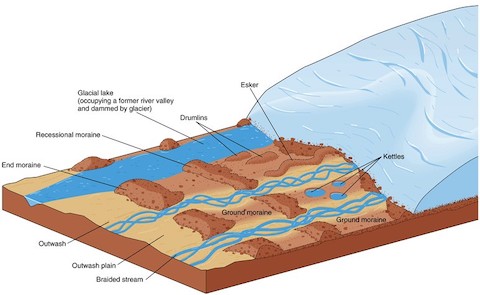
Credit: University of North Dakota
- During repeated ice sheet incursions, the topography of most of the Midwest was flattened as valleys filled with glacial debris. Glaciation causes distinctive geological landforms as it leaves behind deposits of glacial debris collectively known as drift.
- Moraines form gravel mounds under the middle and at the edges of ice lobes.
- Till and outwash—clay, silt and sand with pebbles—are deposited from raging meltwater rivers.
- Lake deposits of silt and clay blanket low-lying spots.
- Loess forms dunes that mantle the area with up to 25 ft (8 m) of windblown silt.
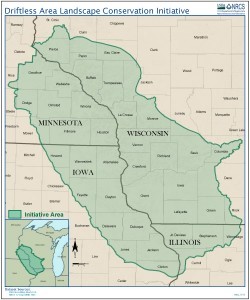
Credit: National Resources Conservation Services (NRCS)
- Remarkably, each time the Pleistocene continental glaciers pressed southward into the American Midwest, they bypassed one region, surrounding it with glacial debris but leaving it intact. Lacking glacial drift, the area has become known as the Driftless.
- Some glacial pulses were deviated to the west by the Lake Superior syncline, while others diverged to the east through the weak shales that became Lake Michigan.
- Additionally, glaciers may have been diverted around the area by hard crystalline bedrock that acted as buttresses to the advancing ice.
- Some researchers suggest that deep fissures and cave systems in the Ordovician karst topography of the area drained meltwater that would typically provide lubrication beneath the massive ice sheets, which caused them to founder and swerve around the area.
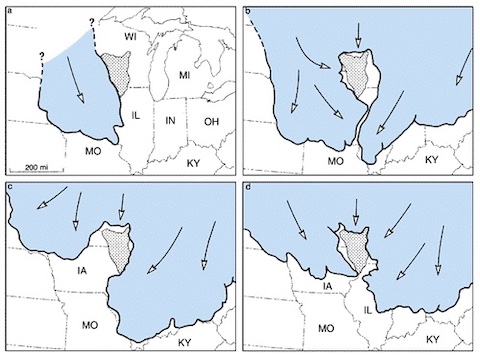
Credit: Illinois State Geological Survey
- The Driftless Area is a 24,000 mi2 (62,000 km2) oasis of vibrant pre-Ice Age ecosystems that existed at the end of the Pliocene Epoch.
- Without the grinding action of the glaciers, the Driftless Area retained its pre-Ice Age drainages, which were enhanced when glacial melting caused catastrophic discharge into the Mississippi River watershed.
- Today’s rugged landscape has steep hillsides, with elevations ranging from 600 to 1,800 ft (200–600 m).
- The karst terrain is dissected by more than 1,200 streams that disappear into sinkholes, coursing through caves and aquifers to reappear as icy cold springs that support a thriving trout-fishing industry.
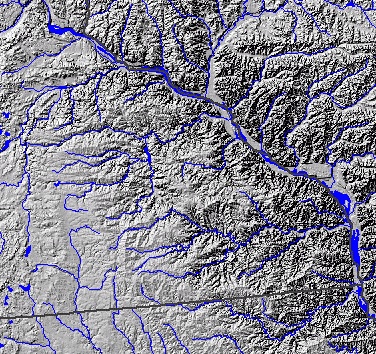
Credit: US Government, Public Domain
- Flora and fauna in the Driftless Area thrived as temperatures warmed at the end of the Pleistocene, while nearby drift-covered areas remained barren.
- Today, patches of shaded meadow within the forest range from a few square feet to about one half-acre, supporting ferns and lichens that normally grow hundreds of miles to the north.
- These refugia are maintained at moderated temperatures as air circulates through the sinkholes, caves and fracture systems of the underlying karst limestone that maintains a fairly constant temperature of 40°F to 50°F (5–10°C).
- These algific talus slopes cool circulating air in the summer and warm it in the winter by as much as 50oF (28oC) compared with ambient conditions.
- Pleistocene relict species can persist in these moderated microclimates, including the threatened plant species northern blue monkshood (Aconitum noveboracense) and golden saxifrage (Chrysosplenium iowense).
- Some species that were thought to be extinct, such as the Iowa Pleistocene snail (Discus macclintocki), have been found in small populations on talus slopes in the Driftless Area.
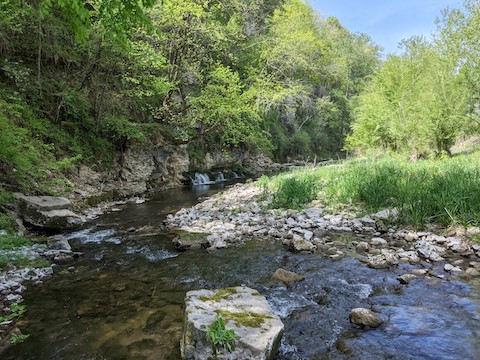
Credit: Gemma Tarlach
- Native Americans have long been drawn to the magical Driftless oasis, decorating caves with ancient art and building effigy burial mounds in the shapes of animals across the landscape.
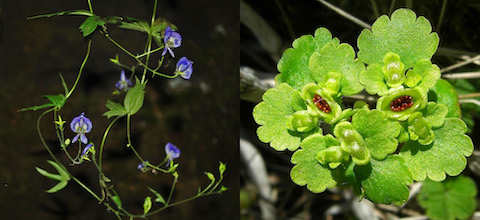
Credit: (Left) Aaron Carlson, via Wikimedia Commons; (right) pellaea, via Wikimedia Commons

